iKamper has introduced X-Cover, a soft-shell roof tent with inventive design and some unique features that are unseen on other roof tents, other than…well other iKamper RTTs. If you like the design of the iKampers, and you already know that you are going to get one of these, it’s a pretty tough decision between the iKamper X-Cover and the Skycamp 2.0
The X-Cover won Overland Journal’s coveted Editor’s Choice Award in 2019, and was also a finalist in Outdoor Retailer’s Innovation Awards. Also in 2019, the X-Cover won the Red Dot Design Award. The iKamper X-Cover is the newer model, and inherited pretty much everything that the Skycamp 2.0 had already had.
So in this comparison between the X-Cover v Skycamp I’ll focus on the differences, similarities and ultimately, trying to answer the question: is the X-Cover better than the Skycamp? And if so, why?
You can read my detailed review on the iKamper Skycamp 2.0 / 4x here, and on the 2-person model, the iKamper Skycamp 2x here.
Also, X-Cover in comparison to other cargo roof top tents here: Roof Tent With Kayak On Top? Not A Problem!
In this iKamper X-Cover v Skycamp comparison;
Who Are The iKamper X-Cover and Skycamp For?
- Size, Space & Interiors
- Fitting, Weight & Pitching
- In Bad Weather
- Accessories
- Availability & Price
- Verdict
iKamper X-Cover v Skycamp
I am blown away by the design of the iKamper X-Cover. But honestly, I don’t know why. Maybe, iKamper’s marketing works, because it’s not as innovative as iKamper would like it to be. Yes, you don’t need an extra PVC cover on top of it when you pack it away, so as with every iKamper roof top tent, the X-Cover brought some of the benefits of a hard-shell roof top tent across. Which is great, but there are many hybrid roof tents who has done something similar…so is it just an overhype?
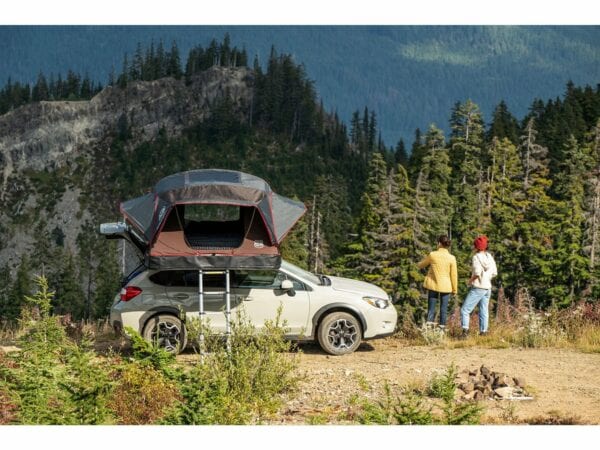
iKamper X-Cover as a trendy accessory…hmm…its much better than that.
There are soft-shell RTTs that are bigger than the X-Cover or the Skycamp. There are RTTs that have slimmer profile (even among soft-shell roof tents). There are RTTs that are quicker to pitch.
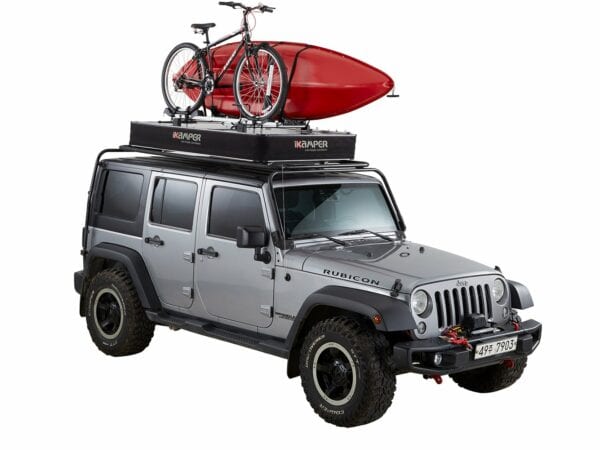
iKamper X-Cover
So the success and popularity of the iKamper roof tents probably root from finding the right balance of the features that normally, you can only find on one type of roof tent or the other. iKamper very smartly amalgamated those in not just one, but 4 products now, and they all bring the most benefits of both worlds (if you like) to the target audience.
Who Are The iKamper X-Cover and Skycamp For?
The target audience: couples, small families with 1-2 kids / dogs who’d like to experience overlanding without the ‘ruggedness’ of it. People who are looking for a pleasant stay for the family over the weekend, to have a great time and who may want to come back the next weekend.
So in many aspects, the iKampers are ‘softer’ than other roof top tents, and they are definitely not the ones that you would strap on top of the Toyota Land Cruiser and head out to an expedition in the Namibian desert for a month…
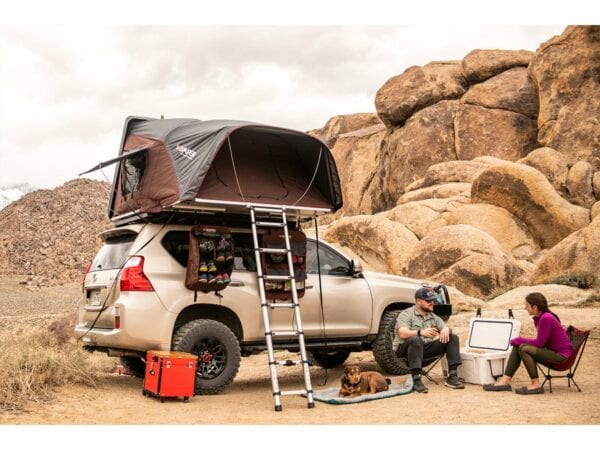
Eeerrr….iKamper Skycamp on a Land Cruiser in the desert…good luck
About iKamper
iKamper is a small, family-owned company from South Korea. It was founded in 2012 by Soon Park, who lived in the States between 2008 and 2012. During these years he and his family spent almost 2 years on the road camping and exploring. When they finally returned to South Korea Soon founded iKamper.
After the moderate success of their first product he launched a Kickstarter campaign for Skycamper in 2017. This became a huge crowdfunding success and raised $2.37 million in 45 days.
The iKamper X-Cover’s design eliminates the bulky PVC cover of traditional soft-shell roof top tents, the cover is the skin of the tent itself. It saves some time getting the cover off, and looks better than the heavy duty tarps of other models but the X-Cover is not just a pretty face.
Size, Space & Interiors
External Size
What is quite apparent, that the X-Cover folds out into a dome-shape, while the Skycamp has more resemblance to the clamshell type roof top tents, with a big plus.
In terms of external size, the X-Cover is smaller when packed up, and slightly bigger when folded out.
While the Skycamp’s external width increases near the shoulders, where the hard-shell cover is attached to the base, the X-Cover remains 190cms wide for its entire length. When packed away, the X-Cover is slightly shorter: the 190cms width doesn’t change, while the Skycamp uses the 218cm long shell as the cover.

iKamper Skycamp – very smart layout for 4 people
Due to the difference in the design, the X-Cover is slightly longer when folded out, although it’s only 20 cms difference in the favor of the X-Cover.
The internal height is the same 115cms, however, the highest point in the X-Cover is at the center of the tent; while the Skycamp is slightly asymmetric.
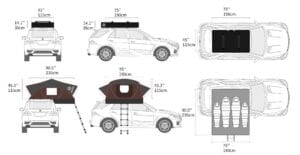
X-Cover – 4 person roof tent on paper, maybe a bit slim even for 2 adults and 2 kids
The X-Cover has an average profile height (36cms); however it’s only true if we compare the X-Cover to other soft shell tents. It can’t beat the 32 cms streamlined profile of the Skycamp, but to be honest it would not make much of a difference when driving.
Interiors
As mentioned, both have a 190cms internal width, however the X-Cover is slightly bigger inside: 4.37 sqm versus 3.99 sqm of the Skycamp. The difference is minimal, and a bit misleading: the X-Cover has a 227 x 175 cm mattress, versus the full 190cm wide mattress of the Skycamp.

iKamper Skycamp 2.0 inside – I love the new design, it is a real upgrade from the Skycamp 4x
It’s only a small difference, but if the Skycamp was a 2+2 family tent, 2 adults and 2 kids would really suffer in the X-Cover: less than 45cms per capita is very slim.
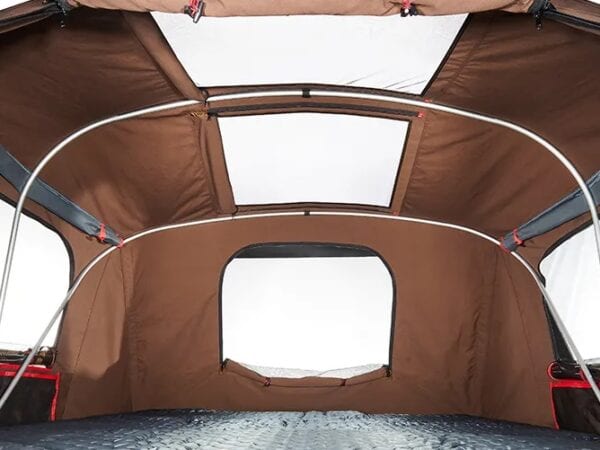
iKamper X-cover interiors – light and airy, plenty of space
The mattress is made of a 1.8″, high density memory foam in the Skycamp. The X-Cover has a much thicker, 2.5″ hdf mattress. Despite that, it is mentioned more than once in user reviews that the mattress in the X-Cover is not thick enough, and where the hinges are, it can’t prevent the hinges from pushing against your hip. So you might need a mattress topper…
In terms of how you feel inside: thanks to its clever mechanism and smart design, there’s not just plenty of space, but there’s plenty of light inside the X-Cover too.

The two roof windows on the X-Cover are unbeatable
The Skyview window was a great feature on the Skycamp, and it is even better on the X-Cover: instead of one roof window, you have 2 of them! There’s plenty of light, plenty of stargazing, and a much lighter feel inside the tent.
Pockets have always been an issue with the Skycamps (the lack thereof…), fortunately the X-Cover has some stowaway under the windows.
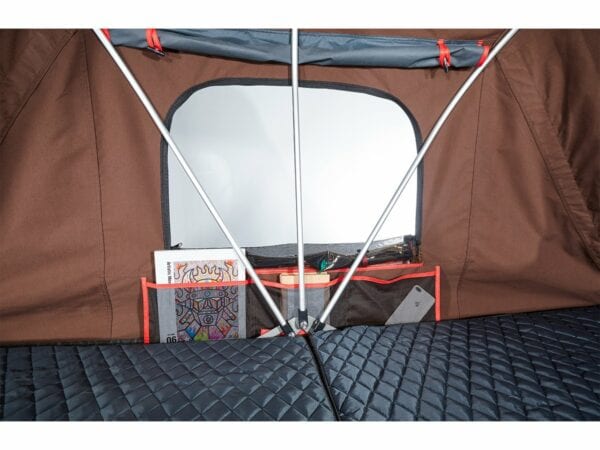
Pockets – plenty of them, yeah! While you can keep your stuff tidy in the X-Cover, the pockets are luxury in the Skycamp
Fitting, Weight & Pitching
The X-Cover is undeniably lightweight, measuring only 55 kgs vs the 73 kgs of the Skycamp. It makes a big difference if fitting on top of your car (much easier to fit the X-Cover) and it comes really handy when you have a smaller car with only 75kgs dynamic roof load capacity, and the crossbars weigh 5kgs…
The Skycamp comes with stainless steel hardshell locks to keep your RTT secure, and you also have the option to upgrade them later.
Pitching time is around 60 sec for the Skycamp, folding it takes a bit longer (90 secs). The X Cover from this respect has a bit of a disadvantage with its 3-minute pitching time, but it’s not bad either.
The only thing that is worth bearing in mind that if you carry stuff on top of the X Cover, you’ll need to remove those first. (There are some cargo-style roof tents that can be opened while the load remains on top – see more about cargo roof top tents here)
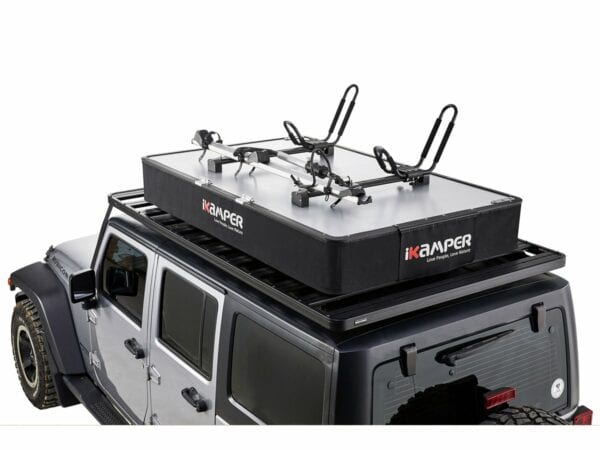
You can put 30kgs on top of the X-Cover
As for the cargo capacity of the X-Cover: you can load 30kgs on top of the X-Cover (when folded), providing that you remain under the roof load capacity of your vehicle. If you’d like to find out how much you could fit on top of your car, have a look at this post detailing more than 150 car models and their dynamic roof load capacity: Roof Top Tent Weight Limits
iKamper X-Cover v Skycamp – In Bad Weather
Both use the same 300gsm breathable, water-resistant poly-cotton canvas as the tent fabric, and they have the same waterproof zippers. Sadly, they both have a polyester flysheet for extra protection from rain. The flysheet is made of a 150D polyester fabric with water-proof coating, it has 3000mm HH (Hydrostatic Head) rating.

The polyester flysheet is detachable on the both the Skycamp and the X-Cover…although its a great feature in the summer, it is also a must after humid weather
(if you are not sure about what those numbers mean, this F.A.Q is just for you: Tent materials, fabrics, specifications and all the acronyms. FAQ.)
To be completely honest I don’t really see the point of having a polyester flysheet on top of a polycotton tent, for two reasons:
- The polycotton tent could have got that water-proving PU layer too (it probably has one anyways).
- The polyester flysheet, despite being relatively thick, has far worse thermal properties.
Although it would keep the rainwater out, easily, in colder mornings condensation will probably build up between the tent wall and the flysheet. It also eliminates the benefit of having a polycotton tent – polycotton fabric is breathable (condensation will much less likely build up inside), while polyester is not.
No wonder, that iKamper has a dedicated section in their F.A.Q. for ‘is condensation normal?‘, explaining that it is. Well, not so much for a polycotton tent, but if you cover it with non-breathable polyester…
Also, if you don’t make sure that you regularly remove the flysheet and dry it out properly, you can expect that funny smell of mold appearing in no time, and then there’s no way you will remove that greenish coloring from within the fibres of the canvas.
The wind resistance of both roof-tents is 40 mph (standing), and 70 mph (transport). This is not outstanding, but if I refer back to ‘who is the target audience’, then the nice family break would probably come to an end well before the wind-speeds reach a constant 40 mph (Gale Force winds)
iKamper X-Cover v Skycamp – Accessories
The X-Cover is a great all-rounder with a lot of accessories such as awning, shoe rack, outer storage, vinyl canopy, wind deflector, movie stand or upgraded mounting brackets. The only accessory that is unavailable for the X-Cover as of 2020, but you can buy it for the Skycamp is the Annex.
Even the inner insulation tent is available for both, giving you the option of turning them into proper 4 season tents. The extra layer of insulation adds a cozy feeling helps keeping you warmer by blocking drafts of air, and better retaining body heat.
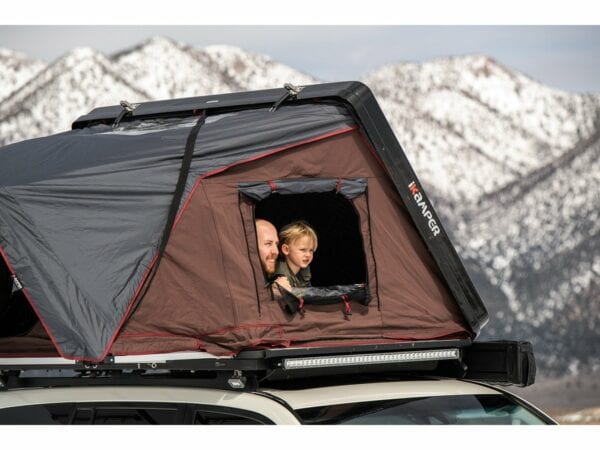
The insulated hard-shell can make a difference…Fortunately, the inner tent insulation is available for both the X-Cover and the SKycamp
I did not mention the crossbars: although the crossbars are integral part of the X-Cover, you can actually remove them (ask iKamper to remove them). It makes the X Cover $400 cheaper as well…
iKamper X-Cover v Skycamp – Availability & Price
Both the Skycamp and the X-Cover are available across the world. The only difference that the optional crossbars on the X-Cover are only optional in the US…you can’t order an X-Cover without crossbars anywhere else.
In terms of price, the Skycamp is more expensive, and not just slightly…
The US price of the Skycamp currently starts from $3,899, while you can take the X-Cover home for $3,199 or $2,799 without the crossbars. That’s a $700-$1100 difference, but fair enough, the Skycamp is a hard-shell roof tent…almost.
The difference in price is even more significant in the UK, where the difference between the base price – Skycamp vs X-Cover with crossbars – is £750: the X-Cover costs £2,750 while the Skycamp starts from £3,500. On todays rate, that’s $966 difference, so the X-Cover is “cheaper” in the UK (or the Skycamp is more expensive…)
Similar in Australia, but the X-Cover for $4,795 is around $700 cheaper than the cheapest Skycamp, or shall I say, only AUS$ 700 cheaper.
iKamper X-Cover v Skycamp – Verdict
Considering the value for money, the X-Cover is a clear winner for me. It’s almost as large as the Skycamp, making it ideal for weekenders, families, friends, and can cater all needs with the plenty of accessories available.
The Skycamp on the other hand cannot really justify why it’s much more expensive. I am not convinced at all, that a hard-shell cover, a streamlined profile & a 15cm wider mattress (but much thinner) are worth that minimum of $700 difference, unless you insist on having (the option for) an Annex.
For much less money, the X-Cover brings you a really lightweight roof tent with an extra sky-view window, thicker mattress and longer sleeping area; plus 30kg cargo capacity on top where you can carry kayaks, paddleboards, surf-boards, bicycles, another roofbox etc.
It’s really a no-brainer for me.
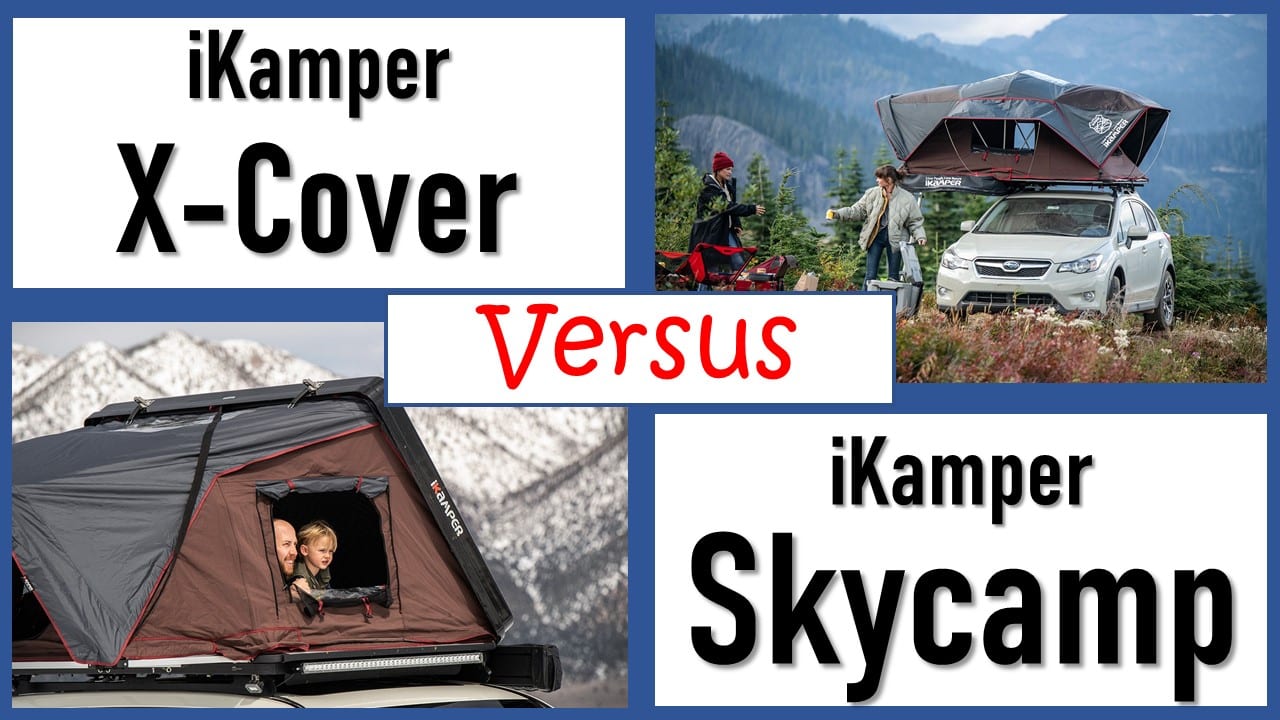
Wondering why the items you’d attach to the rail must be removed to open the tent?
Eg a shovel or Maxxtrax
Is the review referring to a larger item like a kayak attached to the x-cover?
Otherwise a great looking RTT!
Hi Duke,
Good question. First, whatever is on the top while the x-cover is closed, would be on the bottom when the tent is open. Unlike other iKampers, where the hard top functions as part of the roof, the x-Cover’s hard top becomes the flooring.
Also, the opening sequence starts with attaching the ladder across the top of the X-Cover, so any cargo must be removed first. I guess, you might be alright with smaller items ie a shovel, as long as they don’t prevent the ladder from being fitted properly; but you’d probably carry other stuff on the crossbars as well, not just a shovel.
I hope this answers your question! Sorry, it has taken longer than usual to reply!
Regards
Greg
Good breakdown of the two. I really like the X-Cover tent, but the for 4 people sleeping parallel to the tent, perpendicular to the car, the width is way too narrow, but I suppose you could rotate so you sleep parallel to the vehicle, perpendicular to the tent so there’s a bit more space between each person, but I like sleeping perpendicular to the opening so it’s easy to get out without climbing over your tent mates. I’d love if a company could make a tent with at least 20 to 25″ of internal spacing per person so the internal width was 80″ to 100″, I think that would be relatively comfortable for 4 adults as most backpacking style pads tend to be 20″ to 25″ wide x 72″ tall.
Hi Jimmy,
Thanks for your comment!
Yes, the iKamper 2X still has that parallel-to-opening layout, but that’s only a 2-person RTT.
As for the 4-person roof top tents: I think manufacturers deem that slice of the market too slim to bother with – 4 adults are more likely 2 couples, so they would more likely sleep in separate tents, travel by separate cars etc.
There’s only one I can think of that is around 80″ wide (and 80″ long, it’s perfectly square), that’s the inflatable Fjordsen XL (I wrote about it here).
They ship worldwide, it’s even free to some countries (Europe, UK), but there may be customs fee on top of it if you live elsewhere.
Regards,
Greg
Brilliant and practical review, and covers off a lot of the comparative quandries I have been grappling with – thanks for posting.
Cheers Brian!
I have a quick question. I am seriously considering the X-cover but am concerned by the sentiment in the article that suggests the iKamper RTTs are softer than others and not suitable for proper overlanding. I understand that it may not be the intended audience but is there is anything specific about the tent that makes it unsuitable for this such as falling to pieces on rough roads? Or is it only that it is not suitable for gale force winds? My intention is to strap it to my vehicle and go to the Namib desert for a month funnily enough 🙂
Hi, yes I believe I made that sentiment purely down to the fact that where I live, 32 mph wind force is commonplace. Also, there were reports of early iKamper RTTs that bent under the weight of snow plus some winter breeze. I believe this structural issue has been addressed and I haven’t seen anything ever since suggesting that the iKampers fall into pieces – in fact the build quality of them is praised everywhere. On the other hand, this figure has not been updated on their website, and new models come with the same grading…
Not sure what proper overlanding means – going to the Namib desert for a month is way beyond proper in my dictionary (no offence :))
But if you do go with an iKamper or with another RTT, and you have a blog / social media or YT channel I’d be happy to link to it and/or I’d be happy for you to share your experience here!
Thanks Greg, appreciate your reply!
I am based in South Africa and most of our trips are driving through Southern African countries so snow is not really an issue on my side. I also very rarely encounter gale force winds and when it does happen I am happy to make a plan 🙂
The iKamper tents are new in our market and I really like them on paper but there aren’t really people that have stress tested these tents on Southern African roads and environment over a long period of time so I am mostly going on the info that I can find online at this stage.
I take your point on “what is proper overlanding” 🙂 I did not mean it in a derogatory way.
We have have a website which we used as a blog for our first few trips but it was changed in 2017 to feature a pretty cool backpacking through Southern Africa challenge called the Wakati challenge which one of our crew was involved with. The site has not been updated since then so we plan on bringing it back from the dead to do cool things for the trip and we are in serious discussion to create some proper video content too. Covid-19 side-tracked us a bit so will probably only head out on our next adventure in Dec 2021. I will let you know what happens and would be grateful if you link to us when the time comes.
Hey Doug,
iKamper is one of the better ones, someone else just commented on the iKamper vs Roofnest post on how better built the iKampers are.
As an alternative, Alu-Cab’s Expedition tents are made in SA, so I’m pretty sure THOSE will endure.
Your trip sounds really awesome so please make sure you let me know when you head off / update the website!
Hi Greg,
Thanks for the review – it’s really helped sort in my mind the benefits/differences between the two (and I’m definitely agreeing with your verdict! Have an order in right now:) Just checking though – you mention that the mattress is smaller on the X-cover, but all the technical specs and brochure on the ikamper website state that the mattress is the same size. Is that an update on their part? If so, would it be worth updating in your article too?
Cheers,
Dan
Hi,
The Skycamp’s sleeping area – at least at the shoulders – is 190 cms, hence they call it a 2+2-person RTT. The X-cover’s sleeping area is only 175 cms. I noticed, that there’s a slight discrepancy in the info seen across their websites – ikamper.com seems to be a bit more detailed, than the UK site for example
https://www.ikamper.com/pages/skycamp
THE IKAMPER WEBSITE SHOWS AN ANNEX FIR THE X COVER. IS THIS NEW OR A MISTAKE?
I am pretty sure it’s a new addition, this post has not been updated for over a year